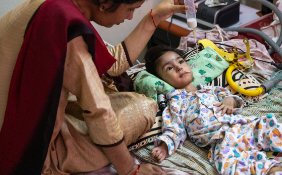Scientists just found out how corals rebuild themselves on the reef
"Coral reefs are declining globally, and their recovery often depends on broken fragments reattaching and growing but that process isn't as simple as it sounds," Dr. Lewis said. "Even after decades of coral research, we still don't fully understand how fragments attach or how to make restoration efforts more effective."
The QUT team also included Professor Peter Prentis and Associate Professor Luke Nothdurft, with collaborators Dr. Crystal Cooper from University of Western Australia and Professor David Suggett from UTS.
Three-step coral attachment process
Using advanced microscopy, the researchers identified a three-phase sequence that coral fragments follow when attaching to the reef surface.
"First, they respond to contact by tissue through an immune response and transitioning their tissues -- almost like flipping yourself inside out," Dr. Lewis said.
"Next, they anchor themselves with this new soft tissue. And finally, they build a skeleton, normally inside the coral, onto the reef using a specialized appendage which can creep over the reef substrate using its cell to grow the skeleton and sterilise any pathogens or other organisms that get in its path."
A suite of high-resolution imaging techniques captured these stages, providing unusually detailed views of coral cellular biology.
Species differences in attachment speed and strength
Dr. Lewis noted that the structure of the attachment appendage is crucial for restoration outcomes because it influences how rapidly a fragment becomes self-sustaining.
"Our findings reveal that while the overall attachment process is conserved across coral species, there are distinct biological differences that influence how quickly and effectively corals secure themselves to the reef," he said.
One noticeable difference was the coral's attachment appendage and its efficiency growing onto the reef in killing pathogens or even other organisms that get in its way with more complex appendages creating leading to faster growth and stronger skeletons in some corals compared to others.
#CoralReefRecovery
#MarineBiology
#CoralRestoration
#OceanConservation
#ReefRebuilding
#ClimateResilience
#Biodiversity
#MarineEcosystems
#SaveTheReefs
#BluePlanet
Website Link : cellbiologist.org
Nomination Link : cellbiologist.org/award-nomination/?ecategory=Awards&rcategory=Awardee Contact Us: info@cellbiologist.org
Follow Us On :
Twitter : twitter.com/account/access
Linkedin : .linkedin.com/in/research-scholar-10278a323/
Tumblr ; tumblr.ccom/




Comments
Post a Comment